Moths are a group of insects that includes all members of the order Lepidoptera that are not butterflies. While butterflies usually take the spotlight with their colors, moths are equally diverse and interesting in their own right.
Moths are incredibly diverse, with over 160,000 species known to science. The species can be of different shape and colors. They as well vary from tiny, drab species to large, striking ones. Some moths are even more colorful than butterflies, with intricate patterns and hues.
Moths can be found in almost every habitat on Earth, from tropical rainforests to arctic tundra. They easily adapt to different environmental conditions and are considered more resilient than butterflies.
Moths also have different feeding habits. Some species are nectar feeders, similar to butterflies, while others are herbivores that consume leaves, flowers or even wood. Interestingly, some moths do not feed at all as adults and rely solely on the energy reserves, they acquired during their caterpillar stage.
Moths serve as pollinators for many plants, especially those that bloom at night. They are also an essential part of the food web, providing sustenance for various predators, including bats, birds and other insects.
Moths have relatively short lifespans compared to some other insects like ants or bees. The adult stage of a moth’s life is the shortest. Most adult moths live for only a few weeks to a few months. Some may live as little as a few days, while others, like the Luna moth can live for several weeks. The purpose of the adult stage is mainly reproduction.

How to tell the difference between Moth and Butterflies
Antennae. The main difference between the two lies in their antennae. Moths tend to have stout bodies with feathery or thread-like antennae, while butterflies typically have slender bodies and club shaped antennae, which are thicker at the tips (bulbous tip).
Wing posture. When at rest, moths and butterflies assume different resting positions. Moths rest with their wings spread flat, covering their bodies like a roof. Butterflies rest with their wings held upright and closed above their bodies.
Coloration and patterns. Moths usually have more muted, duller or cryptic colors while butterflies feature vibrant and colorful wings. Moths’ wings are more intricate, with patterns that help them blend into their surroundings, while butterflies’ wings are often brighter and more conspicuous. However, there are exceptions, so this method of telling the difference may not always be foolproof.
Activity patterns. Moths are more active at night, while butterflies are generally active during the day. Moths are adaptable in their habitat choices, with many species occupying ecosystems like forests, grasslands and urban areas. Butterflies tend to be more specialized in their habitat choices. They usually associated with specific plant species or ecological niches. Moths are usually seen as pollinators of night-blooming flowers, whereas butterflies pollinate day-blooming flowers.
Cocoon vs Chrysalis. Moths form cocoons, which are silk enclosures spun around their pupa. These cocoons can be soft, silken or hard depending on the species. Butterflies form chrysalises, which can be smooth, hard or adorned with metallic-shiny colors.
List of Fluffy, Furry & Fuzzy Moths Species
- Southern Flannel Moth (Megalopyge opercularis)
- Imperial Moth (Eacles imperialis)
- Puss Moth (Cerura vinula)
- Virginia Tiger Moth (Spilosoma virginica)
- Io Moth (Automeris io)
- Rosy Maple Moth (Dryocampa rubicunda)
- White Ermine (Spilosoma lubricipeda)
- Madagascar Bullseye (Antherina suraka)
- Domestic Silk Moth (Bombyx mori)
- Blue Underwing (Catocala fraxini)
- White-marked Tussock Moth (Orgyia leucostigma)
- Gypsy Moth (Lymantria dispar)
- Yellow-tail Moth (Euproctis similis)
- Rusty Tussock Moth (Orgyia antiqua)
- Pale Tussock Moth (Calliteara pudibunda)
- Ruby Tiger Moth (Phragmatobia fuliginosa)
Description & Facts of Moth Species
The Southern Flannel Moth (Megalopyge opercularis)

The Southern Flannel Moth (Megalopyge opercularis), also known as the puss caterpillar, asp, Italian asp, fire caterpillar. While it is called a “moth,” it is actually the larval stage of the moth, and it undergoes metamorphosis to become a moth in its adult stage.
The larva is generously coated in long, luxuriant hair-like setae, making it resemble a tiny Persian cat, the characteristic that presumably gave it the name “puss”.
The color of the caterpillar can be from pale yellow to dark brown. The setae on its body may also have a reddish or orangish tint in some individuals. The “fur” on early-stage larvae is sometimes extremely curly, giving them a cottony, puffed-up look. The body tapers to a tail that extends well beyond the body.
The Southern Flannel Moth caterpillar setae are not just for looks; they contain venomous spines that can cause severe pain if touched. Contact with these hairs can result in a painful sting, skin irritation, and in some cases, allergic reactions.
The adult moth is covered in long fur in colors ranging from dull orange to lemon yellow, with hairy legs and fuzzy black feet. The size can vary, but they are around 1 inch (2.5 cm) in length.
Facts and Identification guide
| Scientific Name | Megalopyge opercularis |
| Other Names | Puss caterpillar, asp, Italian asp, fire caterpillar, woolly slug, opossum bug, puss moth, tree asp, or asp caterpillar. |
| Family | Megalopygidae |
| Size | Around 1 inch (2.5 cm) in length. |
| Coloration | Pale yellow to dark brown |
| Adult Stage Lifespan | One to two weeks. |
Imperial Moth (Eacles imperialis)

The Imperial Moth is a large and impressive species of moth native to North America. Adult have wingspans of about 3.5 to 6.1 inches (9 to 15.5 cm). The females generally being larger than males. The colors of the adult are always primarily yellow with red, brown, and purple blotches.
Like all moths in the Saturniidae family, Imperial Moths go through a complete metamorphic lifecycle, which includes egg, larva (caterpillar), pupa (cocoon), and adult stages. The caterpillars of Imperial Moths are large and green, with spines and a series of distinctive patterns on their bodies.
The adult stage of the Imperial Moth is relatively short-lived, typically lasting only about one to two weeks. Their primary goal during this time is to reproduce. Adult Imperial Moths are nocturnal and are attracted to lights.
Imperial Moths are found mainly in the East of South America and North America, from the center of Argentina to south Canada. In the eastern United States, ranging from the Great Plains to the Atlantic coast. They are more commonly seen in the southern parts of their range.
Facts and Identification guide
| Scientific Name | Eacles imperialis |
| Family | Saturniidae |
| Description | The species was first described by Dru Drury in 1773. |
| Size | From 3.5 to 6.1 inches (9 to 15.5 cm). |
| Coloration | Yellow with red, brown, and purple blotches |
| Adult Stage Lifespan | About one to two weeks. |
Puss Moth (Cerura vinula)
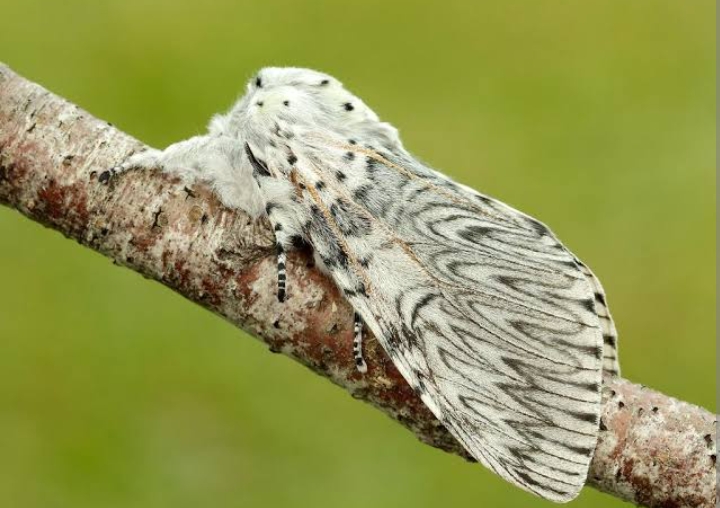
The Puss Moth has a furry and tufted body. Its appearance has led to its common name, “Puss Moth,” because it resembles a furry cat. The adult moth has a wingspan that ranges from 45 to 60 millimeters.
They have white or yellowish-gray forewings crossed by several wave-like dark lines. The hindwings are light gray or whitish in the males, while in the females they are suffused with blackish but almost transparent. The body is whitish gray, with the dorsal abdomen banded in black.
Puss Moths are native to parts of Europe, including the United Kingdom, where they are relatively common. They are also found in parts of Asia.
The caterpillars of the Puss Moth are large and can grow up to 70 millimeters in length. They have a green body covered in bright-colored spots and spines. Its spines can cause skin irritation if touched. The caterpillars feed voraciously on the leaves of host trees.
Unlike the caterpillar, the adult moth does not feed and has a short lifespan focused on reproduction.
Facts and Identification guide
| Scientific Name | Cerura vinula |
| Family | Notodontidae |
| Description | The species was first described by Carl Linnaeus in his 1758 10th edition of Systema Naturae. |
| Wingspan | Wingspan of 58 millimetres (2.3 in) to 75 millimetres (3.0 in) |
| Coloration | white or yellowish-gray |
| Adult Stage Lifespan | About two to three weeks. |
Virginia Tiger Moth (Spilosoma virginica)
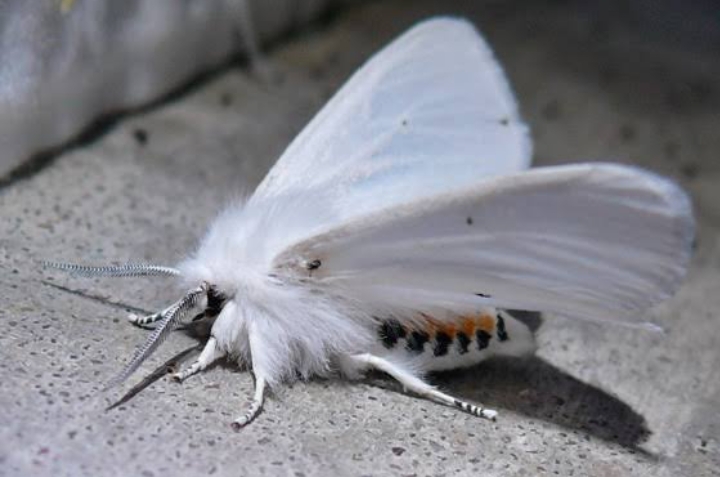
This moth is native to North America and can be found in various parts of the United States, including Virginia, which is one of the states from which it gets its common name. As a caterpillar, it is known as the yellow woolly bear or yellow bear caterpillar. As an adult, it is known as the Virginian tiger moth.
Adult Virginia Tiger Moths are small to medium-sized with a wingspan of about 1 to 1.5 inches (2.5 to 3.8 cm). They have white or pale cream-colored wings with scattered black spots. The body of the moth is also covered in white or pale hairs. The adult moth tends to tent its wings over its back, rather than sitting with them spread.
The caterpillars of the Virginia Tiger Moth are fuzzy in appearance and can be black, orange or yellow. The long, soft hairs are not poisonous, but some people may have an allergic reaction to the bristles on its body. They feed on grasses, clover and other herbaceous vegetation.
These moths are nocturnal and are most active during the night. They are attracted to artificial lights and can be seen around outdoor lights.
Facts and Identification guide
| Scientific Name | Spilosoma virginica |
| Family | Erebidae |
| Range | Eastern and central North America |
| Wingspan | 1 to 1.5 inches (2.5 to 3.8 cm). |
| Coloration | White or pale cream |
| Adult Stage Lifespan | About one to three weeks. |
Io Moth (Automeris io)

Automeris io, the Io moth or peacock moth, is a colorful North American moth. The name Io comes from Greek mythology in which Io was a mortal lover of Zeus.
Adult Io Moths have large wings, with a wingspan that ranges from about 2.5 to 3.5 inches (6 to 9 cm). This species is sexually dimorphic: males have bright yellow forewings body, and legs, while females have reddish-brown to purple forewings, body and legs.
Both males and females have one big black to bluish eyespot with some white in the center, on each hindwing. They resemble the eyes of a larger animal.
The caterpillars are green with rows of spiky, colorful tubercles along their bodies, and they have a pair of long, green, whip-like structures at the front end. These caterpillars are well-camouflaged among the leaves of their host plants.
Io Moths are mainly found in the eastern parts of North America from the eastern United States to parts of eastern Canada.
Facts and Identification guide
| Scientific Name | Automeris io |
| Family | Saturniidae |
| Description | The species was first described by Johan Christian Fabricius in 1775. |
| Wingspan | 2.5 to 3.5 inches (6 to 9 cm) |
| Coloration | Males are bright yellow; females are reddish-brown to purple |
| Adult Stage Lifespan | About one to two weeks. |
Rosy Maple Moth (Dryocampa rubicunda)
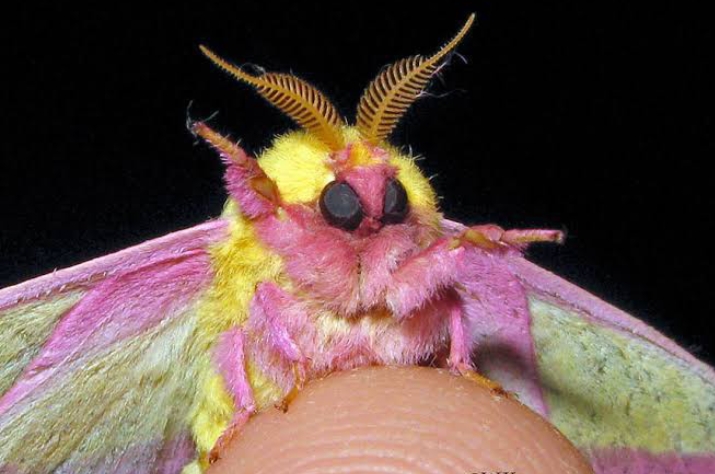
Rosy Maple Moths are small to medium in size with a wingspan of approximately 1 to 1.5 inches (2.5 to 3.8 centimeters). The wings of adult are predominantly pink or rosy in color, with some individuals having variations of pale yellow to cream. The wings also feature contrasting yellowish-green stripes. Males have bushier antennae than females.
The species can be identified by their unique, but varying, pink and yellow coloration. They have reddish-to-pink legs and antennae, yellow bodies and hindwings, and pink forewings with a triangular yellow band across the middle.
The caterpillars are green with white stripes and black spots and are sometimes referred to as “Green-striped Mapleworms.” They mainly feed on the leaves of their host maple trees, particularly red maple, silver maple and sugar maple.
Adult Rosy Maple Moths are usually active at night. They get attracted to artificial lights and can be seen near outdoor light sources during the summer months.
Facts and Identification guide
| Scientific Name | Dryocampa rubicunda |
| Family | Saturniidae |
| Description | The species was first described by Johan Christian Fabricius in 1793. |
| Wingspan | 1 to 1.5 inches (2.5 to 3.8 centimeters) |
| Coloration | pink and yellow coloration |
| Adult Stage Lifespan | About two to three weeks. |
White Ermine (Spilosoma lubricipeda)
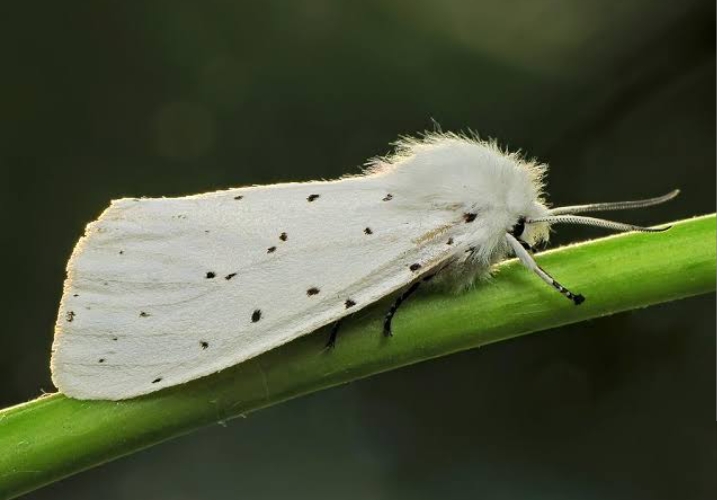
The adult White Ermine moth has white forewings with prominent black spots scattered across them. The hindwings are also white, with some black markings. The body is covered in white fur, which gives it a fuzzy or ermine-like appearance. The wingspan can be from 35 to 55 millimeters.
The caterpillars of White Ermine moths are covered in dense, long hairs and can vary in color, including black, brown, or gray, with yellow or orange stripes running down their sides. They feed mostly on herbaceous plants.
The moths are nocturnal and are active during the night. They are commonly seen flying during the spring and early summer months, from May to July, depending on their location.
This species of moth is found throughout the temperate belt of Eurasia from Europe through Kazakhstan and southern Siberia to Amur Region, China, Korea and Japan. In China several sibling species occur.
Facts and Identification guide
| Scientific Name | Spilosoma lubricipeda |
| Family | Erebidae |
| Distribution | Eurasia |
| Wingspan | 35 to 55 millimeters. |
| Coloration | white forewings with prominent black spots |
| Adult Stage Lifespan | About two to three weeks. |
Madagascar Bullseye (Antherina suraka)

The Madagascar Bullseye is a large moth with a wingspan of about 10-12 centimeters (4-5 inches). The wings of this moth feature a combination of bold black, white, and red markings, which resemble a target or bullseye pattern. This could be the reason for its name.
The caterpillar of this species is green in color and has a cylindrical body covered in numerous spiky projections or tubercles. These tubercles can be red or black and are often arranged in rows along the length of the caterpillar’s body.
As the name suggests, the Madagascar Bullseye is found nowhere else in the world other than Madagascar and the surrounding archipelagos like Mayotte. It is found nowhere else in the world. It is distributed throughout the island’s ecosystems, including rainforests and other wooded areas.
Facts and Identification guide
| Scientific Name | Antherina suraka |
| Family | Saturniidae |
| Description | It was first described by Jean Baptiste Boisduval in 1833. |
| Distribution | It is found on Madagascar and Mayotte. |
| Wingspan | 10-12 centimeters (4-5 inches). |
| Coloration | bold black, white, and red markings |
| Adult Stage Lifespan | About one to two weeks. |
Domestic Silk Moth (Bombyx mori)
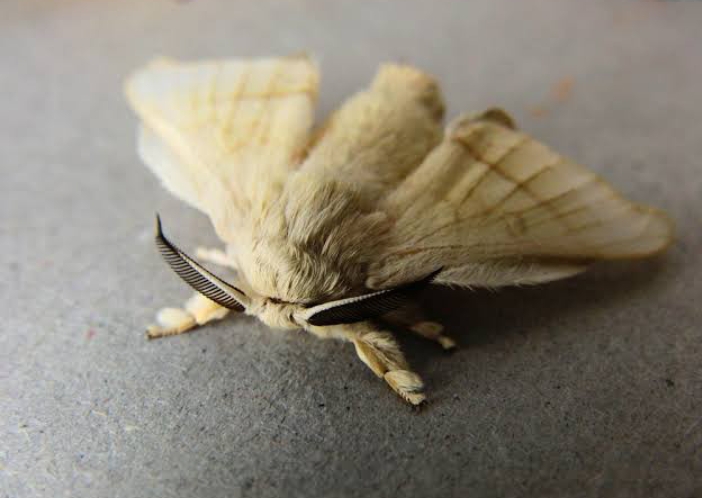
The Domestic Silk Moth (Bombyx mori) is one of the most well-known and economically significant silk-producing insects in the world. The adult moth is relatively large, with a wingspan of about 3-5 centimeters. It has a predominantly white or cream-colored body with some brown markings. The wings are usually beige or pale brown.
The males have feathery, comb-like antennae that are quite large, while the females have thinner antennae.
Silkworm caterpillars are generally white or pale yellow, with some black or brown markings on their body. They have a cylindrical body with several segments, and they grow to a length of about 5-6 centimeters. Their head is small and dark-colored, with chewing mouthparts. They also have a series of prolegs (fleshy, leg-like appendages) along their abdomen.
Adult silkworm moths have non-functional mouthparts and do not feed during their short lifespan. The adult moths are not strong fliers and are mainly focused on mating. Their short adult life lasts only a few days, during which they reproduce and lay eggs.
Facts and Identification guide
| Scientific Name | Bombyx mori |
| Family | Bombycidae |
| Unique Characteristic | They do not fly |
| Distribution | Asia |
| Wingspan | 10-12 centimeters (4-5 inches). |
| Coloration | bold black, white, and red markings |
| Adult Stage Lifespan | About one to two weeks. |
Blue Underwing (Catocala fraxini)

The Blue Underwing has a wingspan of about 50-75 mm (2-3 inches). Its forewings are grayish-brown with markings that help it camouflage while at rest. When the moth is in flight, the hindwings are hidden, but when it is disturbed or at rest, it reveals a brilliant blue or purple color with black bands near the edges.
The caterpillars of this species feed on the leaves of various trees, including oak (Quercus) and ash (Fraxinus), which is where the species name “fraxini” is derived from. The coloration of the caterpillar is green with white or pale lateral stripes running along the sides of its body. The caterpillar’s head is usually brown or black and has small, light-colored hairs or setae.
The Blue Underwing is found in parts of Europe like the United Kingdom, France, Germany and other European countries. It is also present in parts of Asia. It can often be found in woodland edges and open areas adjacent to forests.
They are attracted to lights and may sometimes be found near outdoor light sources. They primarily feed on nectar from flowers.
Facts and Identification guide
| Scientific Name | Erebidae |
| Comon Names | Blue underwing or Clifden nonpareil |
| Family | Bombycidae |
| Description | The species was first described by Carl Linnaeus in his 1758 10th edition of Systema Naturae. |
| Distribution | Asia |
| Wingspan | 50-75 mm (2-3 inches) |
| Coloration | Purple with black bands |
| Adult Stage Lifespan | About one to two weeks. |
White-marked Tussock Moth (Orgyia leucostigma)

The White-marked Tussock Moth (Orgyia leucostigma) exhibits sexual dimorphism. The adult male has wings and is capable of flight. Its wingspan is from 1 to 1.5 inches (2.5 to 3.8 centimeters). The forewings are brownish with white markings and patterns.
The adult female is wingless and has a plump, caterpillar-like appearance. Their body is yellowish-white with black spots. Along the length of their body, they have prominent, tufted structures covered in orange hair-like setae (bristle-like structures).
The caterpillars of this species are hairy and have tufts of hair on their back. They usually have black, white, and orange coloration. The urticating hairs, which can cause skin irritation in humans upon contact.
White-marked Tussock Moths are native to North America and can be found in different parts of the United States and Canada. Some common host plants include oak, willow, maple, and apple trees.
Facts and Identification guide
| Scientific Name | Orgyia leucostigma |
| Comon Names | white-marked tussock moth |
| Family | Erebidae |
| Description | The species was first described by James Edward Smith in 1797. |
| Distribution | North America |
| Wingspan | 1 to 1.5 inches (2.5 to 3.8 centimeters) |
| Coloration | Yellowish-white with black spots. |
| Adult Stage Lifespan | About two to three weeks. |
Gypsy Moth (Lymantria dispar)

Adult gypsy moths have a wingspan of about 1.5 to 2.5 inches (4 to 6 cm). Males are generally smaller and more slender than females. Female gypsy moths are larger and have a bulkier abdomen, especially when they are carrying eggs.
Females Moth are generally white with brown or gray markings. These markings may be more prominent on some individuals, while others may have lighter wings. The males have relatively nondescript white wings with brown or gray markings.
The body of an adult gypsy moth is covered in scales, which are brownish-gray in color. These scales give the moth’s body a somewhat fuzzy or dusty appearance.
Young gypsy moth caterpillars are black with a row of distinctive blue and red dots along their back. As they mature, their color becomes less conspicuous, and they develop a more robust body covered in long, bristle-like hairs. Fully grown gypsy moth caterpillars can reach lengths of 2 to 2.5 inches (5 to 6 cm).
After mating, female gypsy moths lay eggs, which they typically deposit in clusters on various surfaces, such as tree bark, rocks, buildings, or vegetation. Adult moths have a relatively short lifespan, typically living for about a week or two.
Facts and Identification guide
| Scientific Name | Lymantria dispar dispar |
| Comon Names | LLD moth, Gypsy moth, European gypsy moth, North American gypsy moth, or spongy moth |
| Family | Erebidae |
| Description | Carl Linnaeus first described the species Lymantria dispar in 1758. |
| Distribution | Europe, Africa, and North America. |
| Wingspan | 1.5 to 2.5 inches (4 to 6 cm) |
| Coloration | white wings with brown or gray markings. |
| Adult Stage Lifespan | About one to three weeks. |
Yellow-tail Moth (Euproctis similis)

This species has a wingspan of 35–45 mm, the female usually noticeably larger than the male. All parts of the adults are pure white, apart from a bright yellow tip to the abdomen (larger in the female) and a small black or brown tornal mark on the forewing of the male.
It flies at night in July and August and is attracted to light, especially the males.
The caterpillars of the Yellow-tail Moth are black, with sparse black grey hairs, a brick-red divided longitudinal dorsal stripe, white lateral stripes and black head. It usually feeds on trees and shrubs such as alder, apple, birch, blackcurrant, blackthorn, cherry, chestnut, hawthorn, oak, rowan and sallow.
Facts and Identification guide
| Scientific Name | Euproctis similis |
| Comon Names | yellow-tail, goldtail moth or swan moth |
| Family | Erebidae |
| Description | The species was first described by Johann Kaspar Füssli in 1775 |
| Distribution | The Palearctic to Siberiaand south to India and Sri Lanka. |
| Wingspan | 35–45 mm |
| Coloration | All parts of the adults are pure white, apart from a bright yellow tip to the abdomen |
| Adult Stage Lifespan | About two to three weeks. |
Rusty Tussock Moth (Orgyia antiqua)

Adult Rusty Tussock Moths have a wing span of about 1.2 to 2 inches (3 to 5 cm). They are generally brownish-gray in color and have tufted tufts of orange or rusty-colored hair-like structures on their bodies. The female moth has vestigial wings and is flightless; it is light grey-brown (ochreous grey), has “shortly bipectinate” antennae, and a swollen abdomen.
The caterpillars of the Rusty Tussock Moth are known for their tufts of hair-like setae, which are black or dark brown and reddish-orange in color. The hairy caterpillar is spectacular, with “humps”, “horns”, and a “tail” in a combination of dark grey, red, and yellow. The body is dark grey to black, and red tubercules are along the sides and back.
The caterpillars of Rusty Tussock Moths feed on deciduous trees and shrubs, including oak, maple, willow, apple, and many others.
Rusty Tussock Moths are found in North America, Europe, and Asia. They are a widespread species and can be encountered in many habitats. The adult moths do not feed, so only live a short time. The two (sometimes three) generations fly from May till October; in North America, only one generation occurs in a year.
Facts and Identification guide
| Scientific Name | Orgyia antiqua |
| Comon Names | the rusty tussock moth or vapourer |
| Family | Erebidae |
| Seasonality | July to October |
| Distribution | UK (Palaearctic and the Nearctic regions) |
| Wingspan | 1.2 to 2 inches (3 to 5 cm). |
| Coloration | Brownish-gray in color |
| Adult Stage Lifespan | About one to three weeks. |
Ruby Tiger Moth (Phragmatobia fuliginosa)
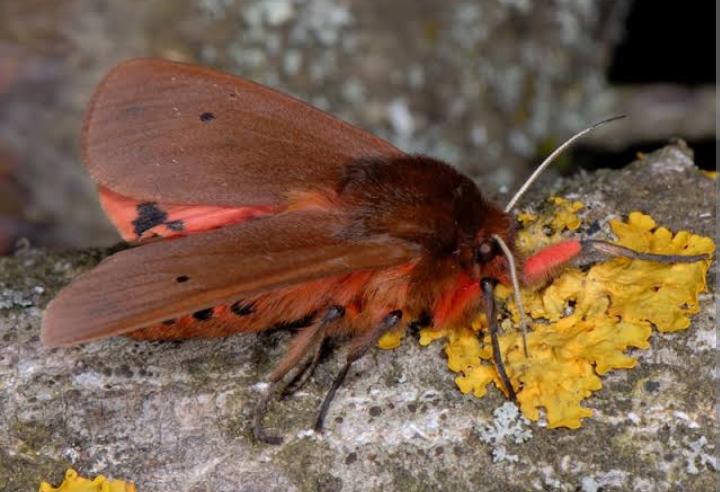
Adult Ruby Tiger Moths have bright red or ruby-colored forewings with black spots. The hindwings are black with a row of white spots along the edges. Their body is covered in dense, fuzzy, and dark-colored hairs. They have a wingspan of around 30-40 mm (approximately 1.2-1.6 inches).
These moths can be found in meadows, grasslands, gardens, and woodlands.
The caterpillars of Ruby Tiger Moths are light or dark grey with a black brown head. The entire body is covered with foxy red hairs. The body has two yellow stripes running from head to the rear. They feed on different plants and adults’ nectar on flowers.
Ruby Tiger Moths are nocturnal, flying at night and resting during the day. They are attracted to artificial lights and can be found near outdoor lights during the summer months.
Ruby Tiger Moths are distributed across Europe and Asia, and their range extends from Western Europe to parts of Asia, including Siberia.
Facts and Identification guide
| Scientific Name | Phragmatobia fuliginosa |
| Comon Names | The ruby tiger |
| Family | Erebidae |
| Seasonality | July to October |
| Distribution | Most of Europe, in North Africa, Russia, Central Asia, Tibet, and in northern areas of North America |
| Wingspan | 30-40 mm (approximately 1.2-1.6 inches). |
| Coloration | light or dark grey with a black brown head |
| Adult Stage Lifespan | About two to three weeks. |